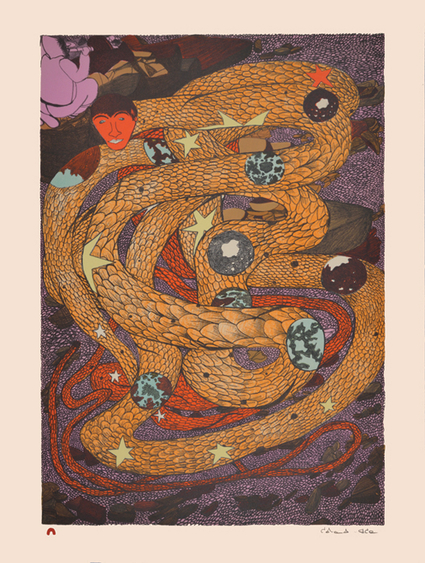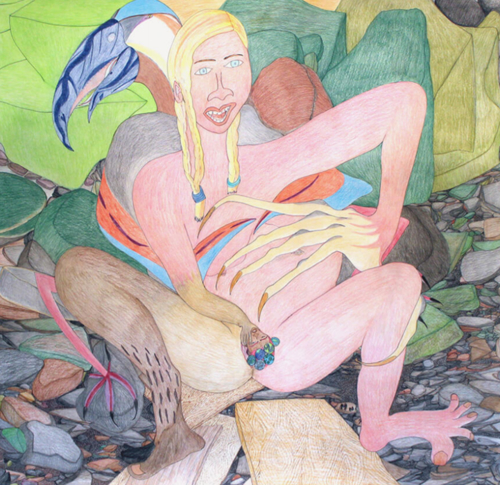Shuvinai Ashoona is a third-generation Inuit artist living in Cape Dorset working within the co-operative, Kinnigait Studios. Her artwork depicts the close connection between humans and their natural environment. This depiction is a crucial reminder of such a connection in a world in which violence towards the earth is committed on a daily basis. To combat the climate emergency it is urgent that humans begin to reconcile their relationship to the earth. Artists, such as Shuvinai Ashoona, who show the bodily connection humans have with the natural world are crucial in assisting this reconciliation.
Pictured below is Ashoona's drawing, Happy Mother. The drawing shows a woman giving birth to a baby crowned with globes whilst being cradled by a prehistoric-looking bird. At first, the bird and the mother seem to be separate life forms, but with further inspection, one notices that the bird and mother are part of the same being. It is unclear where the bird’s egg begins and the woman’s womb ends or to whose leg that foot belongs.
The extension of the bird into the mother and the mother into the bird takes place at one of the most primal experiences one can have: giving birth. The bird’s prehistoric appearance adds a sense of history to the drawing, which serves to reinforce this primal nature of humans and birth. In addition to the bird's prehistoric appearance, the wide mouths of both animals and their morphed bodies is somewhat uncomfortable. This unsettling image is combined with an innocence found in the pencil drawing. Combined, these factors make this drawing quite confronting for the spectator, especially if like many, that spectator is alienated from their natural environment.
In this drawing, Ashoona asks the spectator to reconsider their perception of ‘humanness’. Giving birth is one of the most physical experiences humans can have and it is this moment Ashoona chooses for the body to become one with a bird. Ashoona's work helps us to consider how can we reconnect our physicality with the environment to have a more inclusive relationship with nature.
Crowned with small globes, the baby is connected to the rest of humanity and nature on the earth. Thus, Ashoona’s deceptively simple drawing connects history, nature and the earth in this one image. In doing this, the spectator is reminded of the transience of their human life.
This drawing is a crucial reminder of the brevity of human life and its small role to play in the natural world, which will continue to endure. In revealing this, Ashoona repositions the hierarchy in which humans believe themselves to be separate to, and above, nature. Such works are an important contribution to current conversations surrounding the environment.
Do you see yourself as part of the earth?

